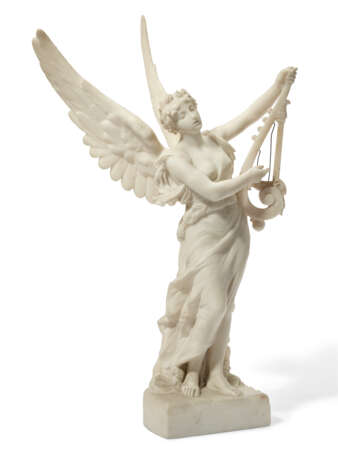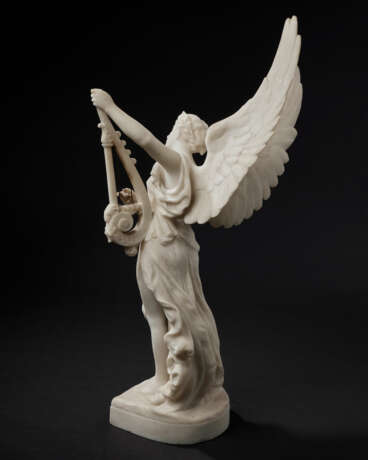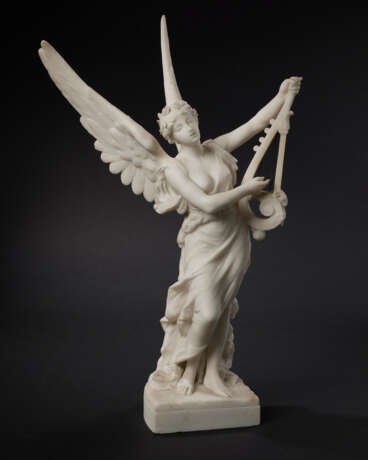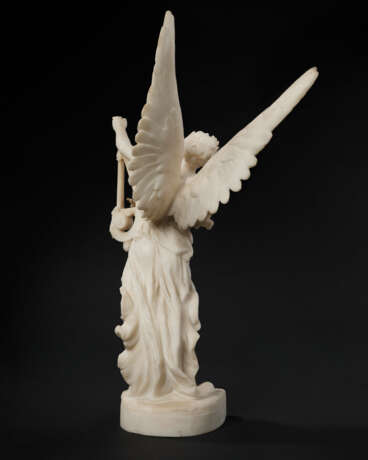SARAH BERNHARDT (1844-1923)
11.06.2025 00:00UTC +00:00
Classic
Startpreis
60000EUR € 60 000
Zum Bieten geht es auf die Webseite
CHRISTIE'S| Auctioneer | CHRISTIE'S |
|---|---|
| Veranstaltungsort | Vereinigtes Königreich, London |
| Aufgeld | see on Website% |
ID 1437190
Los 41 | SARAH BERNHARDT (1844-1923)
Schätzwert
€ 60 000 – 100 000
Le Chant
marbre blanc, signé « Sarah Bernhardt »
marble
H. 57,8 cm (22 ¾ in.)
Provenance
Un appartement du XVIe arrondissement décoré et meublé par Jean Cocteau en 1950, Paris ;
Puis par descendance au propriétaire actuel.
Literature
Bibliographie comparative :
Revue britannique ou Choix d'articles traduits des meilleurs écrits périodiques de la Grande-Bretagne, 1879, volume 319, p. 630.
S. Bernhardt, Ma double vie, Paris, 1907, pp. 329 et 336.
A. Smith, Monaco and Monte Carlo, Philadelphia, 1912, pp. 319-320.
« L’Opéra de Monte-Carlo, aux temps du Prince Albert Ier de Monaco », in Les dossiers du Musée d’Orsay n°38, Paris, 1990, p. 8.
Bulletin de la Société de l'histoire de l'art français, 1992, p. 226.
Sarah Bernhardt. Et la femme créa la star, cat. expo., Petit Palais, Paris, Paris Musées/Petit Palais Musée des Beaux-arts de la Ville de Paris, 2023.
Further details
A MARBLE FIGURE OF THE ALLEGORY OF SONG (LE CHANT), SARAH BERNHARDT (1844-1923), CIRCA 1879
Sarah Bernhardt (1844-1923), born Henriette Rosine Bernard, was a famous and multi-talented actress. As well as being one of the most important French thespians of the nineteenth and early twentieth centuries, she designed her own costums, took part in the creation of stage productions, painted, sculpted and wrote plays, essays and novels.
In the 1860s, she made her first paintings and sculptures. Those creations were a response to her professional disappointments described in her memoirs in 1907: ‘It was then that I took a studio to make sculpture. Since I couldn't use my intelligence and desire to create in the theatre, I used them in another art. And I began to sculpt with a great enthusiasm’.
In 1874, her new passion was a great success Sarah Bernhardt exhibited at the Salon. In 1876 she received an honourable mention from the jury for her sculpture Après la tempête (“After the Storm”). After this success, she wrote : ‘It now seemed to me that I was born to be a sculptor’.
However, some of her contemporaries and fellow critics or sculptors, such as Jules Clarétie or Auguste Rodin, were not ready to sit alongside a woman artist with the reputation of being a diva.
In 1878, considering that gender does not determine talent, Charles Garnier asked Sarah Bernhardt to create a sculpture for the façade of the Théâtre lyrique in Monte-Carlo. The well-known architect of the new Paris Opéra asked an artist who is already famous. Modern and genius, Garnier wanted to employ artists from other artistic fields than their specialties : the actress Sarah Bernhardt sculpted Le Chant and the painter Gustave Doré, also her lover and her teacher, sculpted its counterpart, La Danse.
This astonishing choice was as much criticized by envious contemporary sculptors as it was appreciated by visitors and the curious.
Garnier's desire to work with these artists is documented by correspondence between the lovers ; in particular an undated letter from Sarah to Gustave:
‘Friend,
I'm on a diplomatic mission to you, so I'm going to […] get straight to the point. Here's the point. Garnier is building a big theatre in Monaco, there are two front groups, he ordered me one of them and told me that he would be very keen to ask you for help; but he is afraid that you will refuse, is it true, my dear friend, that you wouldn't like to have me as a colleague - it would make me proud!
Reply quickly to your friend who loves you very much. Tell me immediately if Garnier can make his request without the risk of being refused by your greatness.
Tenderly,
Sarah’
There is also a second letter which seems to be dated after Gustave's agreement:
‘You have made two people happy, Garnier and Sarah Bernhardt, who sends you her love.
S. B.
Garnier will go to your house, I think tomorrow or the next day.
Little is known about how these two monumental sculptures were created. Delivered in patinated plaster and placed on the façade, the 2.50m high figures of Le Chant and La Danse were damaged by time and the weather. Having been restored many times, it is impossible today to know exactly their initial appearance.
Since then, many questions about the sculpture of Le Chant signed ‘Sarah Bernhardt’ are being raised : was it an initial proposal for which Garnier asked for changes ? Was it the sculptor's final idea, the result of which was modified for conservation reasons? Indeed, the movement and appearance of the final sculpture is not the same in this reduced model.
What is more, in the final version, the female figure is accompanied by a young man ; which is not the case with this version – and these questions may never be answered.
This angelic musician, playing the lyre with the mouth open ready to sing a divine melody, supposes that Sarah Bernhardt is part of academic artists. Thanks to this sculpture, she hoped to inscribe her work in time, like an ars longa ; which was impossible during her stage representations.
In 1879, when the Monte-Carlo Opera was dedicated, Jean Bastien-Lepage represented the actress holding and gazing firmly at a sculpture by the painter. This figure of Orpheus with a lyre is reminiscent of our enigmatic sculpture.
The work of the “sacred monster”, as Jean Cocteau nicknamed Sarah Bernhardt, embodies the perfect example of the total artist. Indeed, she participated in the creation of the setting for her future performances. In honor of the opening night of the Theatre, she will return many times in Garnier’s theater to perform.
| Künstler: | Sarah Bernhardt (1844 - 1923) |
|---|---|
| Material: | Marmor, Stein |
| Genre: | Allegorie |
| Herkunftsort: | Westeuropa, Frankreich, Europa |
| Kategorie des Auktionshauses: | Alle anderen Arten von Objekten, Skulpturen, Statuen & Figuren, Statuetten |
| Künstler: | Sarah Bernhardt (1844 - 1923) |
|---|---|
| Material: | Marmor, Stein |
| Genre: | Allegorie |
| Herkunftsort: | Westeuropa, Frankreich, Europa |
| Kategorie des Auktionshauses: | Alle anderen Arten von Objekten, Skulpturen, Statuen & Figuren, Statuetten |
| Adresse der Versteigerung |
CHRISTIE'S 8 King Street, St. James's SW1Y 6QT London Vereinigtes Königreich | |
|---|---|---|
| Vorschau |
| |
| Telefon | +44 (0)20 7839 9060 | |
| Aufgeld | see on Website | |
| Nutzungsbedingungen | Nutzungsbedingungen |












